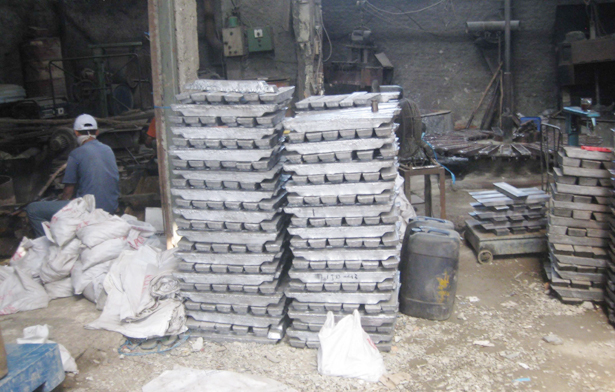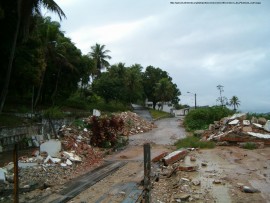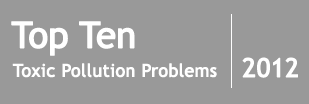Source #2
Lead Smelting
Description
According to the Blacksmith TSIP database, there are an estimated 2.5 million people at risk at almost 70 polluted lead smelting sites investigated in developing countries worldwide. Lead smelting is an industrial process that treats lead ores to remove impurities, and then using furnaces and through the addition of fluxes and other chemical agents produces metallic lead. Primary lead smelting uses mined ores while secondary lead smelting reprocesses use lead scrap material collected through various recovery streams. The primary source of lead ore is from the mineral galena, lead sulfide. In primary lead processing the lead ore is fed into furnaces along with other materials where the sulfur is burned off. The material is then heated in order to smelt and separate the lead metal from slag and other byproducts. The lead metal is collected for refining and further processing depending on its final use. The slag is a waste material that contains zinc, iron, silica, lime, as well as some lead. In well-regulated processes, the slag will be recycled to prevent pollutants from escaping.

In secondary smelting, the lead-containing components must first be separated from the plastic components and then a similar smelting process is used. One of the largest sources of recycled lead materials are used lead-acid batteries, but it can also be obtained from cable coverings, lead pipes, sheets or other metals containing lead. Secondary lead smelting can be done in a similar manner to primary but high lead content waste can be processed at relatively low temperatures and is sometimes carried out in informal, crude and highly polluting facilities.
Exposure Pathways
In the developed world the lead smelting industry has been effective in managing the issues associated with the safe production, handling and use of lead and has raised awareness of sustainability through the International Lead Association’s Lead Action 21 programme. However in countries with inadequate enforcement of environmental legislation lead released from the smelting process can enter the environment through several different pathways. Air emissions can contain lead fumes and dust, sulfur dioxide (a gas) and other various particulates. Fine dust particles can contain arsenic, antimony, cadmium, copper, and mercury as well as lead.[1] Pollutants also are found in water near smelting factories with inadequate environmental controls, where wastewater from smelting processes has been improperly disposed of. Dust and slag can accumulate in soil and seep into ground water or food if agricultural fields are located near smelters. In smelting processes with few or no pollution controls, air emissions could contain up to 30 kg of lead per metric ton of lead produced. [2]
Currently, the Blacksmith Institute’s database shows the bulk of smelting related lead pollution problems in sites are in China, Eastern Europe, South America and Southeast Asia. Global lead consumption was expected to increase by about 6% in 2011 to 10.1 million tons, partly from a 7% increase in Chinese consumption.[3]
Top Pollutant(s)
Lead is the largest contributing contaminant from lead smelting pollution and puts surrounding communities at risk for numerous health problems. As discussed above, there are multiple pathways for contaminants to enter the environment, since lead itself is the input and output of lead smelting. Other pollutants could also include mercury and cadmium.
Global Burden of Disease
Blacksmith Institute estimates that the health of 4.5 million people in the countries included in the TSIP database are potentially at risk from lead smelting. These exposures were determined to result in 2.6 million DALYs in the 49 countries reviewed. In all 49 countries reviewed, lead was the single largest contributor to the disease burden, resulting in more than 13 million DALYs. As a comparison, tuberculosis accounts for about 25 million DALYs.
What is being done?
Modern pollution controls, environmental health and safety standards and precautions can be taken to greatly reduce the incidence of pollutants entering the environment from lead smelting. Newer processes use less energy and capture sulfur more efficiently or use scrubbers and other types of stack pollutant controls to reduce pollutants in emissions.[4] These types of controls are widespread in developed countries; however, these controls can be expensive to implement and are not often found at facilities in developing countries. Smelters in the developing world are concerned about the cost of production, because they are competing for ULAB with the informal sector that pays high prices because they do not employ adequate environmental controls or pay any taxes. Consequently many avoid installing expensive emission controls, even though there is often a benefit in such controls over the long term due to the ability to capture and recover all the lead dust. Another common problem relates to maintenance and proper operation of the emission controls where they exist. Significantly, in lower income countries the industry is often under-regulated and these types of controls are not required for recycling operations. The informal so-called “backyard smelters” are a particular problem for regulators. These are often crude operations which are difficult to locate and when they are, they often pack up and move to avoid regulation and prosecution. In some cases these plants can be upgraded, but in other cases they need to be closed down and the operations transferred to a modern, environmentally sound facility.
Remediation efforts at lead smelters have been successful and there are well-tested standards for the collection and removal of lead contaminated soils. In Russia, the Rudnaya River valley and the neighboring town of Dalnegorsk, the second largest city in the region, were heavily polluted by lead. The population was exposed to high levels of lead contamination caused by lead transport and a local lead smelter. Although the lead smelter was closed soon after Blacksmith first started working there in 2007, over 50% of children tested in the region presented abnormally high blood lead levels. Blacksmith implemented an outreach program that included educational efforts, lead remediation, and medical aid. The project removed the most heavily leaded soil, which was put into environmentally sound landfills. A group of families with children who had the most severely elevated blood lead levels were given treatment to accelerate the expulsion of heavy metals from their systems. Additionally, over 5,000 families were educated on how to reduce exposure and impacts of lead. By identifying and cleaning up the areas most heavily frequented by children, blood lead levels have decreased significantly. By 2009, only two years after the start of the project, the number of children in Dalnegorsk with very high blood-lead levels dropped to 9%.
Footnotes:
[1] “Lead and Zinc Smelting”. Pollution Prevention and Abatement Handbook. World Bank Group. Washington, DC, 1998.
[2] “Lead and Zinc Smelting”. Pollution Prevention and Abatement Handbook. World Bank Group. Washington, DC, 1998.
[3] USGS Minerals Information: Lead. “Lead Statistics and Information.” U.S. Department of the Interior, U.S. Geological Survey, 16 Aug. 2012. Web. Sept. 2012. http://minerals.usgs.gov/minerals/pubs/commodity/lead/
[4] “Lead and Zinc Smelting”. Pollution Prevention and Abatement Handbook. World Bank Group. Washington, DC, 1998.

-
Source #1
Battery Recycling
-
Source #2
Lead Smelting
-
Source #3
Mining and Ore Processing
-
Source #4
Tanneries
-
Source #5
Industrial/Municipal Dumpsites
-
Source #6
Industrial Estates
-
Source #7
Artisanal Gold Mining
-
Source #8
Product Manufacturing
-
Source #9
Chemical Manufacturing
-
Source #10
Dye Industry
-
The Remaining Five Sources



